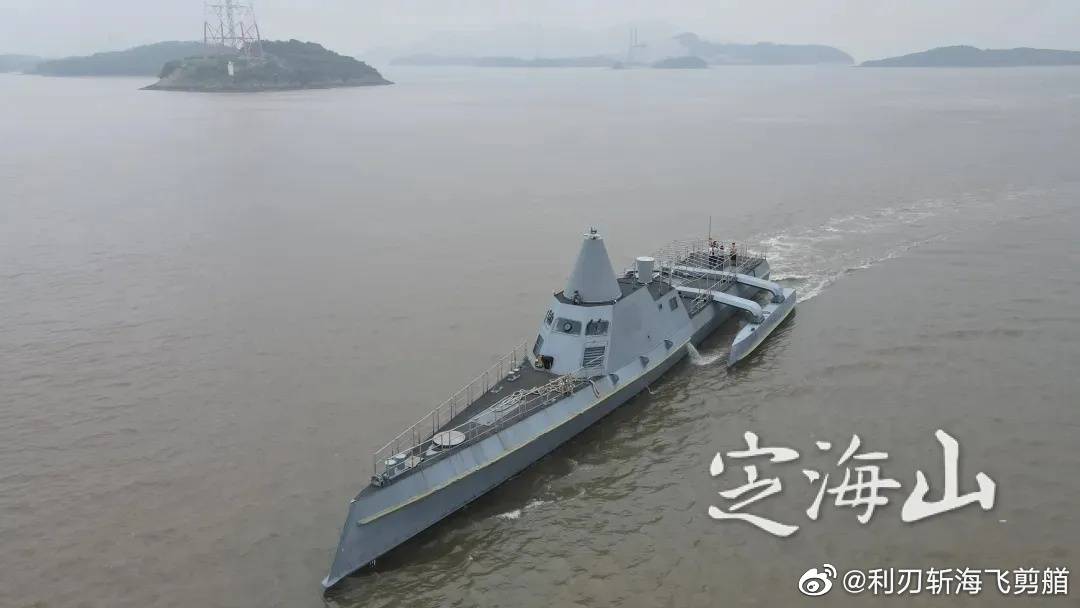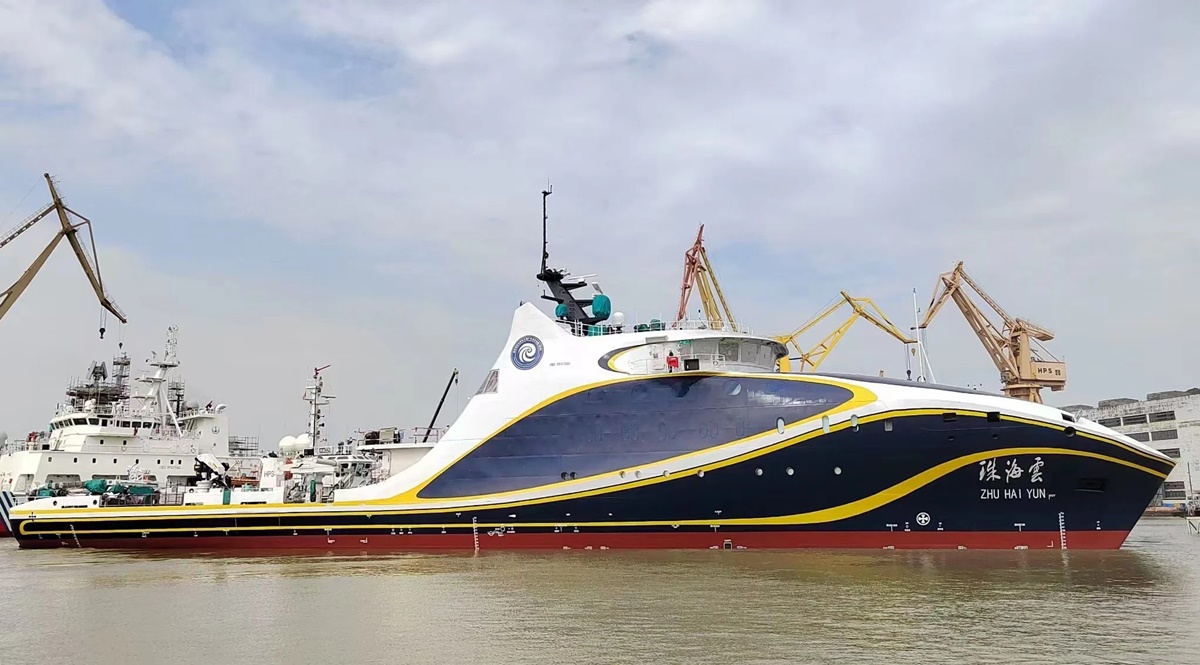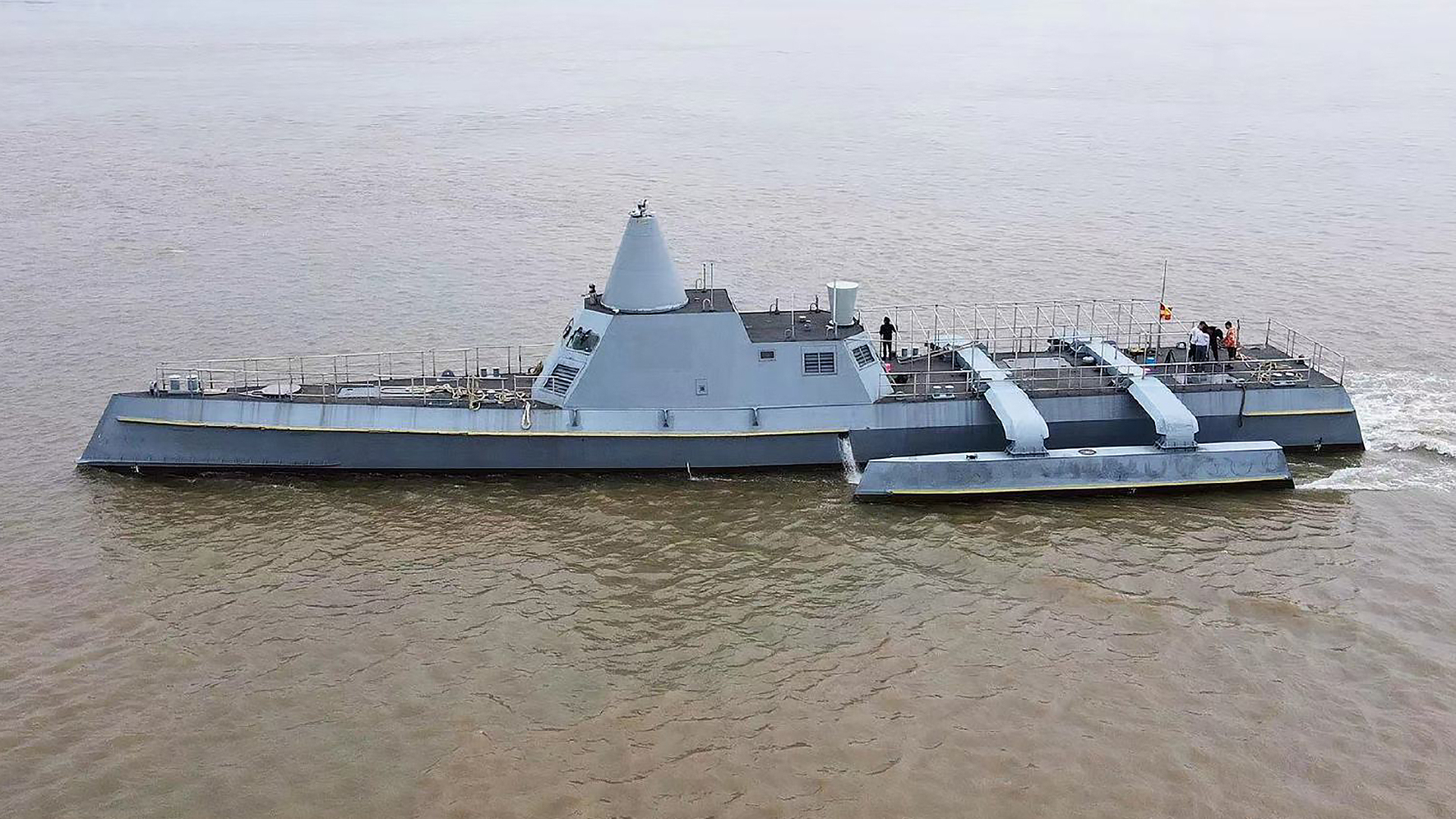What appears to be our best look at China’s developmental uncrewed surface vessel (USV) has emerged online. The ship, which is widely understood to be China’s rendition of the U.S. Navy’s highly successful Sea Hunter, was first seen publicly in 2020.
It is important to note that most of the information surrounding the recent sighting came from Twitter user @sugar_wsnbn’s thread, which is an unverified source and seems to have gotten most of its information from Maritime China magazine through Weibo, which is a Chinese microblogging site. The thread explains that an undisclosed entity conducted its first factory sea trials with the USV on June 7 near Zhoushan Island in Zhoushan City, Zhejiang Province. The thread goes on to say that the point of the exercises was reported to have been centered around testing the USV’s autonomous navigation system to ensure that it can execute its purported purpose of patroling oceanic regions where possible adversarial activity and enemy submarines are expected to be.
It can be seen from the photos that the unnamed USV adopts a trimaran structure, meaning that it has been developed with three hulls comprised of the main hull and two smaller hullforms that are installed parallel to the ship’s body. The Twitter thread also claims that the USV has a displacement of about 200 tons, is about 151 feet in length, and can speed along at 20 knots or more depending on the operational circumstances. It also states that the ship is designed to safely navigate in sea state six, which constitutes relatively rough waters. Although, the Twitter user also mentioned that there have been claims that the autonomous navigation system aboard the USV has displayed shortcomings when faced with congested waters.
In the user’s first post, they state that the USV was apparently domestically developed by a company called Zhejiang North China Intelligence Technology beginning in late 2015 in hopes of realizing a desire for a stealthy USV with high-performance navigation and intelligence systems. The thread also adds that the ship was officially launched in Jiujiang City, Jiangxi Province in August 2019, and what followed was a number of tests conducted on Lake Poyan allegedly meant to confirm the USV’s autonomous navigation capabilities.

The Twitter thread’s final installments elucidate that the vessel is reported to have finally arrived in Zhoushan City in October 2021, where it was prepared for another round of navigation tests, this time in the open ocean. The tests purportedly lasted about three hours, during which time the USV’s autonomous navigation data is said to have been collected and processed by whatever organization led the exercises.
Initial reports about this vessel’s existence and its whereabouts began to surface in 2020 when independent defense analyst H I Sutton shared new evidence of the USV’s location at a port in China, which was originally posted to Weibo. A follow-up posted by Sutton in 2021 utilized satellite imagery to pinpoint the USV’s position outside a Chinese shipyard where it was likely kept until any official tests could be performed.
China’s optionally manned drone ship shares extreme similarities with the U.S. Navy’s Sea Hunter, and likely was built to directly emulate that vessel’s test objectives. Physically speaking, both were manufactured with a triple-hull design and autonomous navigation capabilities, but there are minor structural differences that help distinguish between the two. The Sea Hunter clocks in at about 132 feet, has a full load displacement of 145 tons, a top speed of 27 knots, and is intended to be operational through sea state 5. China’s version has a conical mast and angled deckhouse, while Sea Hunter has a more traditional configuration. The tumblehome bow on China’s ship is also more severe than the blunt bow on Sea Hunter. This feature may also point to a secondary research objective in studying tumblehome bow physics in an operational environment.

Sea Hunter was actually originally designed as part of a project focused on hunting enemy submarines, similar to what the Twitter thread is claiming to be one of the primary purposes of the elusive Chinese USV. But many more potential roles have been tested or suggested for the Sea Hunter and its more recently built sister ship Sea Hawk, as well as other USVs of other sizes that have followed, that include general intelligence-gathering operations, manned-unmanned teaming, and acting as weapons platforms. Basically, Sea Hunter is a historic vessel that largely spurred the Navy’s quickly accelerating unmanned surface vessel revolution — albeit one that still has yet to be fully proven or defined. In fact, Sea Hunter and Sea Hawk will participate in the massive RIMPAC wargames that will kick off soon off Hawaii. One of the ships has already arrived in Pearl Harbor — the type has made the trans-Pacific crossing autonomously multiple times before.
The point being is that the massive success of the Sea Hunter and the unmanned advances it has spawned gives China every reason to push their own version of the concept into advanced testing. This is especially the case as Beijing’s own unmanned surface vessel ambitions are quickly expanding.
In May of this year, China launched another unmanned vessel that has been designated Zhu Hai Yun and will serve as a ‘drone ship’ namely for marine research purposes. Although, as previous coverage posted by The War Zone suggests, Zhu Hai Yun could be just as beneficial in a military context and could act as a hub for various unmanned weapons and surveillance systems.

Whether or not China’s Sea Hunter USV ends up being anywhere near as successful as Sea Hunter is yet to be seen, but it looks like testing is now expanding for the ship so we will probably be seeing more of it soon.
Contact the author: Emma@thewarzone.com
